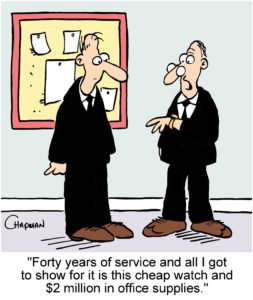
B2B OFFICE & PROMOTIONAL SOLUTIONS
- 1.833.3WE.ROCK
- info@shopeveryday.ca
- Blog

B2B OFFICE & PROMOTIONAL SOLUTIONS

As funny as this little cartoon is Employee theft really is no laughing matter.
A pad of paper, a few pens and a stack of Post-Its – if that’s your idea of employee theft you need to realize it also includes stealing time, money, intellectual property and office equipment as well as confidential and other valuable information.
Employee theft must be addressed because it’s so prevalent and the sheer volume of stolen supplies adds up to billions of dollars a year in losses for small businesses.
More than 50% of workers admit to “borrowing” something from the office without returning it and experts report an upswing in theft by long-term, trusted employees. In fact, many describe the culprit as the well-liked, affable, loyal employee who has been with the firm for years.
Yet, many business owners and managers continue to make a number of incorrect assumptions:
Employees tend to steal because:
What do employees tend to “borrow” the most often? A CareeBuiiler.com survey found that the most commonly purloined items are office supplies (15%), money (14%) and merchandise (11%).
The most common supplies taken:
| Pens | Envelopes | Paper clips | Sugar and coffee |
| Pencils | Highlighters | Chairs | Printing for personal use |
| Rulers | Post-Its | Garbage Bags | Laptops |
| Copier paper | Calculators | Toilet paper | Computer monitors |
| Notebooks | Staplers | Postage stamps | Digital devices |
| Scissors | Tape dispensers | Mugs | Cellphones, USB drives, computer mice, mouse pads, CD ROMS |
Preventive strategies focus on hiring practices, anti-theft procedures and clear, consistent policies on how thieves will be dealt with:
Hiring Practices:
HR Guidelines:
Anti-Theft Policies
Review office supply expenses regularly and compare against comparable historical periods. If costs are up for no apparent reason, it’s worth investigating further.
Anti-theft procedures:
If you suspect thievery:
After reading this free 12-page guide, you'll know the right questions to ask when it comes to pricing, order and delivery process, product support, invoicing & payment terms, and more.
Copyright © 2024 ECI Software Solutions, Inc. All rights reserved.
Images and content are owned or licensed by Everyday Office Supplies Inc.